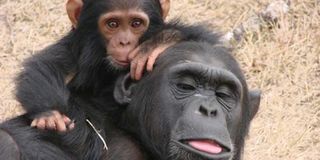Something for future generations

Mwanzo and her baby Ajabu at the Sweetwaters Chimpanzee Sanctuary. PHOTO/COURTESY
What you need to know:
- It’s hard to fathom that this chimp spent the first nine years of his life in a cage suspended above a workshop to attract customers. The steel-rod prison had space only for him to stand upright or sit hunched on two feet – hence his unusual gait – walking.
- We’re at the chimp sanctuary, Kenya’s first and only one, for a very special occasion. It’s the launch of PEGAS – Project to End Great Apes Slavery to fight the brutal trade where entire families of chimpanzees are massacred to get to the infant.
- Infants are preferred because they are easy to train, ship and handle. A mature chimp on the other hand is 10 times stronger than a human and not an easy pet to handle.
Year after year I’m filled with more admiration for Poko.
He’s the chimp at Sweetwaters Chimpanzee Sanctuary on Ol Pejeta Ranch in Nanyuki. He’s getting on in age – thinning hair and so on – but he’s still full of spunk.
Watching him on a cool mid-year morning on the equator with Kenya’s tallest mountain decked in cloud, he’s attempting to do cartwheels but manages only a half show.
It’s hard to fathom that this chimp spent the first nine years of his life in a cage suspended above a workshop to attract customers. The steel-rod prison had space only for him to stand upright or sit hunched on two feet – hence his unusual gait – walking.
Then come Angela and Ajabu – the two naughty little girls. Angela’s imitating Poko flinging stones through the fence. She thinks it’s so much fun amidst squeals of excitement.
We’re at the chimp sanctuary, Kenya’s first and only one, for a very special occasion. It’s the launch of PEGAS – Project to End Great Apes Slavery to fight the brutal trade where entire families of chimpanzees are massacred to get to the infant.
ABANDONED CHIMPS
It’s a trade that’s steadily increasing mainly due to demand from China for their entertainment spots in shopping malls and circuses or through drive-in ‘safari parks.’
Infants are preferred because they are easy to train, ship and handle. A mature chimp on the other hand is 10 times stronger than a human and not an easy pet to handle.
Karl Ammann, a wildlife investigator, has seen the worst side of this trade. He’s showing us a cage – just the size to fit a five-foot person with no room to move.
In 2005, the crate was found at the Jomo Kenyatta Airport when staff saw tiny fingers poking through holes and child-like whimpering coming from it.
When opened, five chimp babies were squeezed in the box. Without food and water for several days, they were in bad shape and one had died.
Watching the survivors play in their pen, this is one happy story of chimps that were rescued.
NEARLY EXTINCT
Next is to see how the four Northern white rhinos are faring. The Northern white rhino is on its last leg.
With only seven left in the world, it’s extinct in the wild and listed as Critically Endangered. Its range once spread over northwestern Uganda, southern Chad, southern South Sudan, the eastern part of Central African Republic and northeastern Democratic Republic of the Congo before poaching brought their numbers from 500 to 15 in the 1970s and 1980s with only seven accounted for in 2007.
In 2009, four of the six Northern whites from Dvur Kralove Zoo in the Czech Republic were translocated to Ol Pejeta in the hope that they would breed in their ancestral home, Africa. So far that has not happened.
However, the Southern white rhino was considered extinct in the late 19th century.
Then in 1895 a small population of less than 100 individuals was discovered in South Africa. Today the Southern white rhinos number 20,000 and the only ones that are listed as non-endangered rhinos. A few were translocated to Kenya in the 1990s and are doing well.
Maybe there’s some hope then for the Northern white rhino, that a few dozen might pop up from some hidden enclave in Cameroon or Uganda and the world can once again celebrate a success story and leave something for future generations to see instead of the squalor of over-populated cities.
ON THE EQUATOR
Log on to www.olpejetaconservancy.org to read more about the 90,000-acre wildlife haven. It’s East Africa’s largest black rhino sanctuary and the only place in Kenya to see chimpanzees and the Northern white rhino. There’s plenty of cat-life too with lions, leopards and cheetah prowling about.
The equator passes through the conservancy and there are some beautiful places to stay at like Sweetwaters Serena Camp or Ol Pejeta House and for a private house try Pelican House. The conservancy is 190 kilometres from Nairobi. Prior bookings are a must.




